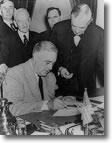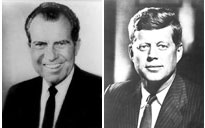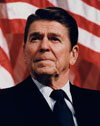The President's relationship with the media
The media has always played an important role in politics, particularly that of the office of the President. The media also plays an important role in forming public opinion. In the early 1900s, the newspaper was the main means of communication. This would later be replaced by motion picture news spots, then radio broadcasts, television, and today, the Internet.
Franklin Delano Roosevelt

View these videos to learn more (highlighted in red)
The President has always used the media to promote his agenda to the public and improve his public image.
While all presidents have tried to do this, a few presidents have made it an art form. Franklin Delano Roosevelt, John F. Kennedy and Ronald Reagan are all well known for their natural ability to communicate through the media. In the 1930s President Franklin Delano Roosevelt used the radio to connect on a personal level with the people in what would be called "Fireside Chats." He mastered the medium, comforting the American people as they came out of the Great Depression and went into World War II. Take a step by in time and listen to an excerpt from NPR of FDR's first Fireside Chat on the banking crisis.
The President has always used the media to promote his agenda to the public and improve his public image.
While all presidents have tried to do this, a few presidents have made it an art form. Franklin Delano Roosevelt, John F. Kennedy and Ronald Reagan are all well known for their natural ability to communicate through the media. In the 1930s President Franklin Delano Roosevelt used the radio to connect on a personal level with the people in what would be called "Fireside Chats." He mastered the medium, comforting the American people as they came out of the Great Depression and went into World War II. Take a step by in time and listen to an excerpt from NPR of FDR's first Fireside Chat on the banking crisis.
Nixon-Kennedy

By the 1960's television had surpassed the radio as the main source of media in American homes. It is widely believed that the televised presidential debate between Richard M. Nixon and John F. Kennedy is what won the election for Kennedy. Take a look for yourself. View a video clip from the Prelinger Archives of the 1960 Kennedy-Nixon debate.
Ronald Reagan

President Ronald Reagan was nicknamed the "Great Communicator" because of his ability to reach out to the people to explain policy and discuss the state of the nation (and the world) through the television. Visit NPR’s collection of audio and video clips of Ronald Reagan speeches. Listen to the first selection on the page. It is an audio montage of his speeches which aired on his 90th birthday. Next, scroll down and listen to the “Evil Empire” excerpt. These clips will give you a good sense of his use of humor to connect with the people, as well as his oratory skills. Feel free to view and listen to other excerpts on this page.
Although politicians intend to use the media to get their message out to the people, it is questionable whether the media is biased in how they deliver that message. How a news anchor discusses a story and how the images are used all portray a certain image. Commentators can spin the message different ways depending on their opinion:
-Do they like the politician? Or not?
-Is the network more conservative? Or liberal?
These are all questions with no concrete answers, but give us great food for thought as we become active participants in government.
The Public's Relationship with the Media
Today Americans have access to the news 24 hours a day. The media plays an important role in what we know about government and the world. It has the ability to decide what stories will be told, how much they will tell, and the slant they will take on any particular story. The media gives its opinion through newscasts, editorials in newspapers and on news shows, through the publishing of Political Cartoons and investigative reporting. The media often gets blamed for swaying public opinion, but there is not much evidence to that being true. Many people watch or read the news and filter the information through their already established political beliefs.
F. D. Roosevelt© 2006 Library of CongressPrints & Photographs Division[reproduction number LC-USZ62-15185] Clipboard © 2006 clipart.com John F. Kennedy, Ronald Reagan, Richard Nixon: The National Archives
Let us know what you think: Please complete a brief SURVEY concerning this new 5.04 assignment to help us make it great for all students. Thanks!
Although politicians intend to use the media to get their message out to the people, it is questionable whether the media is biased in how they deliver that message. How a news anchor discusses a story and how the images are used all portray a certain image. Commentators can spin the message different ways depending on their opinion:
-Do they like the politician? Or not?
-Is the network more conservative? Or liberal?
These are all questions with no concrete answers, but give us great food for thought as we become active participants in government.
The Public's Relationship with the Media
Today Americans have access to the news 24 hours a day. The media plays an important role in what we know about government and the world. It has the ability to decide what stories will be told, how much they will tell, and the slant they will take on any particular story. The media gives its opinion through newscasts, editorials in newspapers and on news shows, through the publishing of Political Cartoons and investigative reporting. The media often gets blamed for swaying public opinion, but there is not much evidence to that being true. Many people watch or read the news and filter the information through their already established political beliefs.
F. D. Roosevelt© 2006 Library of CongressPrints & Photographs Division[reproduction number LC-USZ62-15185] Clipboard © 2006 clipart.com John F. Kennedy, Ronald Reagan, Richard Nixon: The National Archives
Let us know what you think: Please complete a brief SURVEY concerning this new 5.04 assignment to help us make it great for all students. Thanks!
